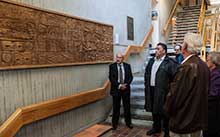Feilding Panel 1964

The Feilding Panel is a collaborative piece, the result of a workshop run by notable educator Gordon Tovey (1901-1974) in 1964. For one week ten arts advisors worked in shifts to carve wooden panels found at an old Feilding mill, gaining experience in a key element in Māori craft so as to be better equipped to introduce it into schools.
The Panel reveals the burgeoning talents of many of the carvers. For example it clearly shows the emerging styles of at least two key artists: Cliff Whiting, whose intricate patterning is instantly recognisable; and Para Matchitt, with his playful geometry. It is one of the first times both those artists had carved.
Gordon Tovey was a strong advocate for the central place of art in education, believing it essential to the learning process. His appointment in 1946 as the first supervisor of art and craft for the Department of Education saw a reinvigoration of arts education in New Zealand. He wanted to ensure that students gained access to both Māori and Pakeha artistic traditions, and also believed that in order to support the creativity of students, and to enable true understanding of artistic instruction, teachers required their own creative practice. To this end he established mentoring opportunities for arts advisors/teacher trainees such as the carving workshop that produced the Feilding Panel.
The Tovey scheme provided similar opportunities for other first-generation Māori artists including Fred Graham, John Bevan Ford, Ralph Hotere, Katarina Mataira, Cath Brown, and Sandy Adsett, encouraging them to draw on both Māori and European artistic sources and fostering innovation through the use of modern tools, materials, and ideas. It has been identified as key to the development of contemporary Māori art.
The Feilding Panel stands as a precious legacy of a defining time in the careers of several artists and also in the development of biculturalism in Aotearoa New Zealand. It also uniquely captures the pedagogical underpinnings of a bygone Education Department.
For more information about this and other works in the Victoria University of Wellington Art Collection visit The Adam Art Gallery Collection online.
